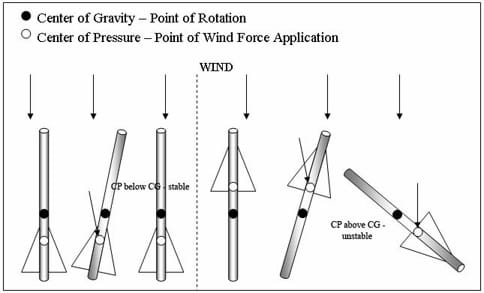One thing to remember, is that, unless something moves around inside the rocket (like the parachute and wadding sliding backward down the tube under the g-forces of launch) and the mass of the burning propellant being converted into gas and being expelled from the rocket, the CG does not change in flight. Now, the propellant burning off is constanly making the rear of the rocket lighter, and the forward mass should be fixed, so actually during flight the CG is slowly moving forward... (in model rockets anyway-- in large liquid propellant rockets, the CG is actually slowly moving aft as the remaining propellant is of course in the bottom of the stage tanks, but that's a separate issue unless you're designing rockets for NASA...).
CP, on the other hand, DOES move around during flight... the location of the CP is dependent upon a number of issues-- fin size, rocket length, tube diameter, transitions and their orientation, etc. Probably the most important thing that affects the CP in flight is that the CP moves forward as the angle of attack increases, that is, the further the nose moves to the side of the direction of flight, the further forward the CP moves. The CP moves to its maximum forward position due to this effect when the angle of attack (the direction the nose is pointing) is 90 degrees to the direction of flight-- IOW, the rocket would be flying sideways. That is why the cardboard cutout method of determining the CP location (center of lateral area) is the most conservative. It's also why a marginally stable rocket, one where the CP is too close to the CG, may be easily thrown off-course from wind or other disturbances, and could potentially go unstable at any moment. For one thing, the closer the CP is to the CG, the less "leverage" the forces acting on the fins has to turn the rocket back to the direction of flight-- the forces of the airflow in front of the CP are counteracting the forces of the air acting behind the CP. If the rocket isn't pushed far off course (small angle of attack), the forces on the fins should be enough to nudge the rocket back on course. If, however, the nose is pushed too far off course (too high an angle of attack) the CP COULD shift forward enough either to be in exactly the same place as the CG, or worse yet, IN FRONT of the CG... The rocket would simply continue to go wherever it's pointed if the CG and CP overlap-- the aerodynamic forces on the fins are perfectly balanced by the aerodynamic forces acting on the nose/forward area of the rocket in front of the CP. In the case of the CP shifting in front of the CG, the rocket will go completely unstable and will not recover... it will simply pinwheel out of the sky. A neutrally stable rocket (CP and CG in the same place) may straighten out (if the rocket stops rotating long enough to go where its pointed, lowering the angle of attack to near zero and thus pushing the CP rearward again, or by the CG moving forward as propellant burns off and moves the CG forward), but what direction its pointing is anybody's guess... and when the next disturbance will push it off course or possible cause it to go completely unstable. Sometimes the rocket straightens out and flies in some unanticipated direction roughly upward... sometimes it starts pinwheeling or skywriting and flops to the ground...
That's the reason why the usual stability margin is described at a minimum as "one body tube diameter behind the CG". The cardboard cutout method (center of lateral area) is the most conservative CP location method because it is the most conservative, showing the CP in it's "worst case scenario" location (at a 90 degree angle of attack, which theoretically the rocket should never reach if the CG is forward of this point at liftoff). Other CP calculation methods usually are "more realistic" and put the CP further rearward, BUT it's possible that the CP point is actually forward of this point, or will move forward of this point if the angle of attack gets too high...
One other method of determining the CP is the swing test-- tie a loop of string around the rocket and tape it down to the body tube, and swing it, starting at the CG (where the rocket hangs horizontally in the loop of string, showing the weight on one side is balanced by weight on the other). If the CP is behind the CG, if the rocket is swung around in a circle around one's head (or suspended in smooth airflow) the rocket SHOULD turn nose-forward (demonstrating stability). Now, if the loop is slowly moved backward bit by bit, sooner or later the rocket will not point straight ahead anymore-- it will point in some completely random direction-- this is the actual CP location. If the string is moved further back, soon the rocket will begin to point "tail first" as spun around one's head in a circle (or in smooth airflow). This demonstrates that the CP is BEHIND the string's present location, as the forces acting on the front of the rocket (in front of the string toward the nosecone) is now stronger than the forces of the wind acting on the fins and rocket parts behind the string, causing it to face "backwards" into the airflow.
Later! OL JR







